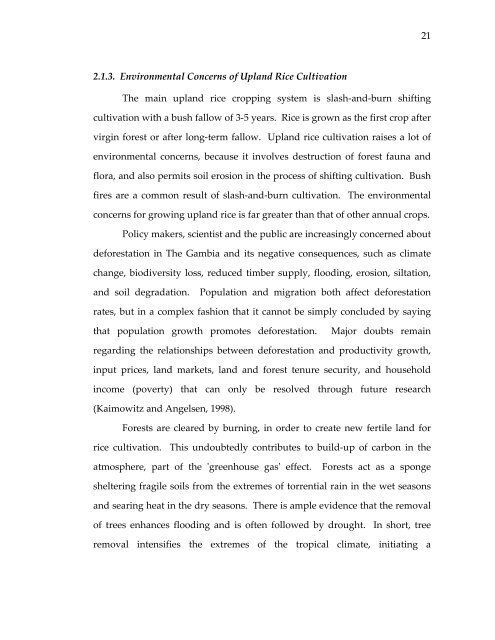Management of rice production systems to increase productivity
Management of rice production systems to increase productivity
Management of rice production systems to increase productivity
Create successful ePaper yourself
Turn your PDF publications into a flip-book with our unique Google optimized e-Paper software.
2.1.3. Environmental Concerns <strong>of</strong> Upland Rice Cultivation<br />
The main upland <strong>rice</strong> cropping system is slash‐and‐burn shifting<br />
cultivation with a bush fallow <strong>of</strong> 3‐5 years. Rice is grown as the first crop after<br />
virgin forest or after long‐term fallow. Upland <strong>rice</strong> cultivation raises a lot <strong>of</strong><br />
environmental concerns, because it involves destruction <strong>of</strong> forest fauna and<br />
flora, and also permits soil erosion in the process <strong>of</strong> shifting cultivation. Bush<br />
fires are a common result <strong>of</strong> slash‐and‐burn cultivation. The environmental<br />
concerns for growing upland <strong>rice</strong> is far greater than that <strong>of</strong> other annual crops.<br />
Policy makers, scientist and the public are increasingly concerned about<br />
deforestation in The Gambia and its negative consequences, such as climate<br />
change, biodiversity loss, reduced timber supply, flooding, erosion, siltation,<br />
and soil degradation. Population and migration both affect deforestation<br />
rates, but in a complex fashion that it cannot be simply concluded by saying<br />
that population growth promotes deforestation. Major doubts remain<br />
regarding the relationships between deforestation and <strong>productivity</strong> growth,<br />
input p<strong>rice</strong>s, land markets, land and forest tenure security, and household<br />
income (poverty) that can only be resolved through future research<br />
(Kaimowitz and Angelsen, 1998).<br />
Forests are cleared by burning, in order <strong>to</strong> create new fertile land for<br />
<strong>rice</strong> cultivation. This undoubtedly contributes <strong>to</strong> build‐up <strong>of</strong> carbon in the<br />
atmosphere, part <strong>of</strong> the ʹgreenhouse gasʹ effect. Forests act as a sponge<br />
sheltering fragile soils from the extremes <strong>of</strong> <strong>to</strong>rrential rain in the wet seasons<br />
and searing heat in the dry seasons. There is ample evidence that the removal<br />
<strong>of</strong> trees enhances flooding and is <strong>of</strong>ten followed by drought. In short, tree<br />
removal intensifies the extremes <strong>of</strong> the tropical climate, initiating a<br />
21
















